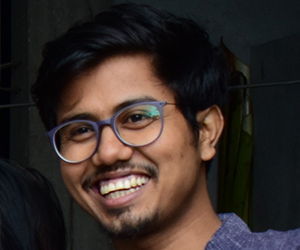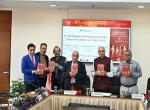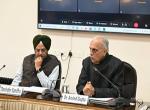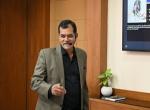On 17th June 2024, Vivekananda International Foundation (VIF) organised a Vimarsh lecture on ‘Religion, Dharma and the Indic Religious Tradition’ by Prof. Arvind Sharma. Prof. Sharma, formerly of the Indian Administrative Service (IAS), is the Birks Professor of Comparative Religion in the School of Religious Studies at McGill University in Montreal, Canada. He has also taught at various universities in the United States (Northeastern, Boston, Temple, Harvard), Australia (Queensland, Sydney), and India (Nalanda). He has published extensively in the field of Indian religions and comparative religion. He is the General Editor of the Encyclopaedia of Indian Religions (Dordrecht: Springer, 2017). Prof. Sharma was also instrumental in adopting the Universal Declaration of Human Rights by the World’s Religions at a global conference held in Montreal in 2016.
This lecture was the first of a series of lectures and discussions on Indic religious traditions. Dr. Arvind Gupta, Director, VIF, in his opening remarks of the session talked about all the Indic religions, namely Hinduism, Jainism, Buddhism and Sikhism, having a common root in the Indian soil and constituting the essence of Indian mindset. Dr. Gupta talked about the differences and similarities in the Indic religions. He raised questions like “What are the threads that bind the Indic religions and how are Indic religious traditions relevant to the contemporary world?” He highlighted the primary beliefs of Indic religions. After the opening remarks by Dr. Gupta, the keynote address was delivered by Prof. Sharma, followed by remarks from Prof. Dr. Shashi Prabha Kumar.
In his keynote address, Prof. Sharma highlighted the difference between ‘religion of study’ and ‘study of religion’. All major religions like Hinduism, Christianity, Islam, Buddhism, Judaism, Sikhism and Jainism have a long history of study internal to that tradition. ‘Study of religion’ is a relatively recent phenomenon whose beginning can be placed in the middle of the 19th century. ‘Religion of study’ remains within the confessional framework of the tradition that is being studied, but ‘study of religion’ makes no such assumptions. In the ‘study of religion’, one does not have to believe in the religion he or she is studying. Hence such study is called the academic or non-confessional study of religion. Prof. Sharma also pointed out the difference between the terms ‘world religions’ and ‘religions of the world’. ‘World religions’ is restricted to the prominent religions of the world, but ‘religions of the world’ as a category includes all the possible religions of the world.
Once British colonial rule was reestablished after the Revolt of 1857, the British set about the business of administrating the country in a systematic way. The British proceeded to acquire the required information about the Indian people through a series of census operations that started in 1871. These censuses also gathered information about the religious identity of Indians. The religious identity of India before the British had an amorphous and plural character. But the censuses were carried out on the assumption that one could belong to only one religion at a time. As a result of these censuses, the amorphous and fluid dimensions of India’s religious identity began to solidify along distinct lines. In the early stages of the census in Punjab, a person could declare himself or herself to be both a Hindu and a Sikh. This option was not available in the later stages of the census. Certain communities practiced religious syncretism to such an extent that they could not be classified as either Hindu or Muslim. The composite religious identity of India was being fragmented into distinct religions as a result of these operations.
By the early decades of the 20th century, certain sections of the Hindu intellectuals became concerned that the various elements of this composite tradition were being turned into separate religions. They were especially concerned about the religions of Indian origin, which were in general more accepting of religious diversity than the religions of foreign origin present in India, such as Christianity and Islam. These intellectuals couldn’t politically intervene in the process of religious fragmentation of society. It was in this context that V. D. Savarkar came up with the concept of Hindutva. He argued that religions like Hinduism, Buddhism, Sikhism, and Jainism shared the same culture and considered it their holy land.
Prof. Sharma stated that the concept of Indic religious tradition consisting of Hinduism, Buddhism, Jainism and Sikhism was also taking shape outside the western academia in the public life. Thus, the evolution of the concept of Indic religious tradition has two dimensions, namely a western dimension that took shape through the academic study of religion and a national dimension in the development of Hindutva. He distinguished between the expressions, Indian religious traditions and Indic religious traditions. While the word Indian religious traditions covered all religions present in India, the expression Indic religious traditions only included religions of Indian origin. Another thing that we need to recognise is the distinction between the western word religion and the Indic word Dharma.
It is not possible for a person to be a Jew, a Christian and a Muslim at the same time. However, it is possible for one to be a Hindu or a Buddhist or a Jain or a Sikh at the same time. This is possible because the concept of religious identity with which these religions operate is not as exclusive as the one underlining the Abrahamic traditions. Prof. Sharma provided multiple instances from the history of the interpenetration of the Dharmic traditions. The Indic religious traditions present a model of interaction among the various religions that is different from the Abrahamic family of religions.
In agreement with Prof. Sharma, Prof. Shashi Prabha Kumar explained the concept of Dharma in the Indic tradition. The concept of Dharma is so deep in its intent and diverse in its content that it is difficult to define it in clear terms. She highlighted the various definitions of the concept of Dharma as defined in the Rig Veda, Mahabharata and Manu. The conduct of a human being is the ultimate Dharma. She added that it is not merely an intellectual exercise to discuss the difference between religion and Dharma but to understand some of the ongoing issues. The session was then open for discussion followed by closing remarks by Dr Arvind Gupta.










Post new comment